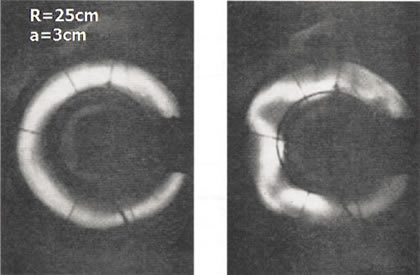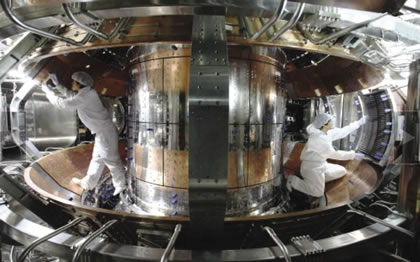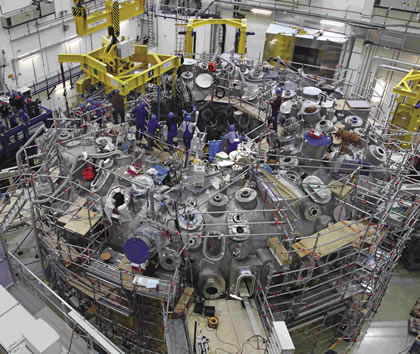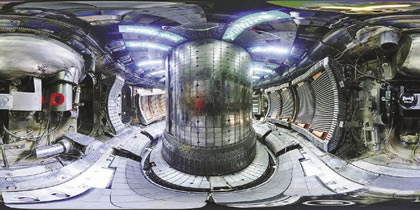America Must Become Promethean Again!
Ignite the Power of Fusion Energy
by Megan Beets
May 2017
A PDF version of this article appears in the January 13, 2017 issue of Executive Intelligence Review and is re-published here with permission.
This is Part II in a series on the importance of the Fourth Law, i.e. a Fusion Science Driver Program, of The Four New Laws economic recovery program as presented by Lyndon LaRouche in June, 2014.
Out of our laboratories may come a discovery as important as the Promethean taming of fire.
—Atomic Energy Commission Chairman Lewis Strauss, 1958
View full size
tech.sina.com.cn
China’s Experimental Advanced Superconducting Tokamak (EAST). |
Jan. 9—Did you know that alongside the breathtaking achievements of our 1960s space program, and in the same spirit of optimism for the future of mankind, the United States had a vigorous program to achieve nuclear fusion—the process which fuels the Sun—as a power source, with a commitment to making it happen by the 1990s?[1]
As was obvious during those decades of optimism and growth, the leap to fusion power is not an option for humanity, but a necessity for our continued progress.
By the 1990s, fusion scientists had created gases at temperatures of 500 million degrees (25 times hotter than the center of the Sun), invented new materials and methods to contain and control these gases, and in their experiments had wielded power equivalent to that flowing through the entire nation’s energy grid. When the immense powers and potentials of fusion are no longer contained in laboratories, but are widely disseminated through all sectors of human work and life, we will have made a leap upward to an entirely new platform of development.
View full size
A kink instability, pictured here, can develop in thin plasma columns with strong current along the axis, such as in tokamaks, and other fusion reactor designs. Once they develop, these instabilities quickly disrupt the plasma confinement, and must be controlled. |
Today, the potential of controlled fusion stands before us as a breakthrough imminently achievable within the new world paradigm of “win-win” cooperation now emerging under the leadership of China and Russia. For decades, within the now-collapsing paradigm of the trans-Atlantic system, the cynical line has been, “fusion is always 50 years away.” Now this lie is falling away, and we stand at the brink of a renewed optimism around mankind’s ability to overcome any challenge.
In Part I of this article, “Return to the Road of Infinite Progress: Revive a Crash Program for Fusion Power” published in the Dec. 23, 2016 EIR, we covered the elementary principles of creative growth that distinguish man from all beasts, and demand our continuing breakthroughs to more and more energy-dense modes of power (e.g. chemical fuels, to nuclear fission, to fusion).
Here in Part II, we will examine why there is great potential today to organize humanity to conquer fusion, starting with important developments of the past 12 months in Europe and Asia, as well as the promising recent achievements of the U.S. program, despite its crippled condition.
Fusion Is—and Always Was—
An International Affair
As was recognized from the 1950s’ beginnings of fusion efforts in the United States, the Soviet Union and Europe, full mastery of the atomic nucleus, put to work for mankind, would not just be a victory for one nation, but would revolutionize our species as a whole, giving it seemingly limitless potential.
The Head of the Indian Atomic Energy Commission, Homi J. Bhabha, who presided over the first international conference on fusion in 1955, said in his presidential address, “I venture to predict that a method will be found for liberating fusion energy in a controlled manner within the next two decades. When that happens the energy problems of the world will have been solved forever, for the fuel will be as plentiful as the heavy hydrogen [deuterium] in the oceans.”
There are many challenges to be overcome as we tame the fire of fusion. A fusion reaction is the uniting of two light nuclei (e.g. hydrogen) into one, which results in a tremendous release of energy in the form of electromagnetic radiation and high-energy particles. We can capture that energy to produce electricity, heat for industrial processes, and many other advanced applications, such as rocket propulsion.
In the standard theory, for two nuclei to get close enough to fuse, they must overcome the Coulomb barrier, created by the tendency of two similarly-charged particles (in this case, the positively charged nuclei) to repel one another. This requires a tremendous input of energy. A successful, energy-producing fusion reaction—one which yields more energy than was required to bring it about—requires that the fuel is confined at a high enough density and temperature, and for a sufficient time, such that the energy being given off heats the fuel without further external input. In the process of trying to make this happen, plasma instabilities and other surprising behaviors of the fusion fuel have disobeyed our mathematical formulas, and challenged our assumptions about the characteristics of matter and energy.
Today, stunning new breakthroughs are being made by the impressive fusion efforts which have been developed around the world. If a vigorous crash program of international cooperation were initiated within a new win-win paradigm, we could finally bring to fruition what the old system had placed “always 50 years” beyond our grasp.
Leadership in the EAST
China, which began its fusion program in the 1970s, has developed one of the world’s only tokamaks (a type of fusion machine) that uses advanced superconducting magnets, the Experimental Advanced Superconducting Tokamak (EAST) housed at the Institute of Plasma Physics in Hefei. China is the only nation today which is increasing its domestic fusion budget, and it has the intention of graduating 2000 fusion scientists by 2020 (there are currently more than 300 master’s and PhD students studying fusion in Chinese universities).
In the recent 12 months, work at the EAST facility has made important progress, and the insights gained from this work can benefit fusion research internationally.
In February 2016, it was announced that with recent upgrades, scientists were able to maintain a plasma in the EAST tokamak at 50 million degrees (over twice the temperature of the Sun’s core) for 102 seconds,[2] setting a new record for plasma creation. The goal is to sustain a plasma for 1,000 seconds, at twice the temperature. Professor Luo Guangnan, deputy director of the EAST project, said, “It is a milestone event, a confidence boost for humanity to harness energy from fusion.” In November of 2016, another record was set, maintaining a plasma of 50 million degrees for 60 seconds in a “high confinement mode,”[3] nearly double the previous record.
Both of these recent milestones are exciting and necessary advances, and they were not accomplished alone. Scientists in the United States, at General Atomics in San Diego, collaborated with their Chinese colleagues on the experiment, and have even begun operating the tokamak remotely for a “third shift,” during the nighttime in China.[4] The cooperation is viewed as very valuable on both sides. “We have made a very good start of international collaboration in fusion research between China and the United States, and we are very proud to be a pioneer in this field,” said Dr. Xianzu Gong, of China’s Institute of Plasma Physics.
View full size
National Fusion Research Institute
Korea’s KSTAR tokamak with fully superconducting magnets, after a recent upgrade that will allow the study of pulses of up to 300 seconds duration. |
The recent achievements have bolstered confidence to move forward with the next step toward fusion energy, the Chinese Fusion Engineering Test Reactor (CFETR), for which approval is expected in China’s next Five Year Plan. This facility would be dedicated to solving the remaining engineering challenges, such as the need for new materials, before moving ahead with a demonstration power plant. The CFETR could come online as early as 2025.
Promising work is emerging in other parts of Asia. For example, in December 2016, a record of 70 seconds of plasma high-density mode operation was achieved in Korea’s KSTAR tokamak, breaking its prior record of 55 seconds, set in 2015. KSTAR is the world’s only other advanced superconducting tokamak, and began operation in 2008. Major upgrades to KSTAR are planned over the next few years, intended to allow work that would lead to a demonstration power reactor, KDEMO.
Both of these programs, as others, have been carried out with significant international cooperation, and scientists from all over the world have contributed their work and insights toward this wonderful common effort.
Achievements in the West
Alongside the ongoing disintegration of the system of geopolitics and Wall St. in the west, which has held back scientific progress for decades, glimmers of real optimism appear in the fusion laboratories of Europe and the United States.
View full size
Max Planck Institute
The Wendelstein 7-X experimental stellarator reactor in Greifswald, Germany. |
At the Max Planck Institute for Plasma Physics in Greifswald, Germany, scientists and students completed the construction of the Wendelstein 7-X, the largest stellarator in the world, in 2014. The stellarator is a design for a fusion machine based on a different concept than the more common tokamak—imagine a twisted tokamak—and may avoid many of the plasma instabilities which challenge the basic tokamak designs.[5]
In February 2016, the Wendelstein 7-X began its experimental operation, and in December released a report that the very complicated geometry of its stellarator is accurate to within 1 part in 100,000. The analysis of Wendelstein 7-X stellarator’s geometry was completed with collaboration from the United States and other fusion programs, all of which show great excitement at what can be learned from this unique approach.
Finally, in the United States, though decades of budget cuts have crippled the momentum of a very promising national effort, fusion work has continued in our National Labs and universities, and in recent months has underscored the crime of denying adequate funding to our program.
View full size
cc/Bobmumgaard
Alcator C-Mod tokamak at MIT. |
On Sept. 30, the last day of its operation due to budget cuts,[6] the Alcator C-Mod tokamak at the Massachusetts Institute of Technology set a new world record, achieving a plasma pressure (one of the key parameters in an energy-producing fusion reaction) of 2 atmospheres, surpassing its own previous record. The Alacator device, a high-magnetic-field compact tokamak, is of a unique design, and could be readily restarted with restoration of funding. Dale Meade, formerly of PPPL, said of the work, “This is a remarkable achievement that highlights the highly successful Alcator C-Mod program. . . The record plasma pressure validates the high-magnetic-field approach as an attractive path to practical fusion energy.”
The Alcator C-Mod is joined in being shut down by the second of three major fusion devices in the United States: the National Spherical Torus Experiment (NSTX-U) at PPPL, which had to stop operations in July 2016, when a magnetic coil shorted out. This leaves the DIII-D tokamak at General Atomics as the only major operational fusion device in the United States. A sane and moral U.S. president would restore funding to the Alcator C-Mod immediately, and mobilize to facilitate rehabilitation of the NSTX-U as quickly as possible.
Out of necessity, more and more U.S. fusion scientists are turning to international fusion facilities to exercise their talents. Though international cooperation is indispensable, the United States has a deep and revolutionary history in contributions towards conquering fusion, and in the context of joining the new paradigm now emerging in the world, we must immediately restore full funding to our own domestic fusion efforts, that we might maximize humanity’s resources in this critical endeavor.
Fusion for All Mankind—
On the Earth and Beyond
As the world undergoes a profound and revolutionary realignment, and a new paradigm of “win-win” cooperation begins to take shape, humanity has a renewed opportunity. Nations are being brought together to pursue the common aims of mankind for the mutual benefit of all, supplanting the ideology of the imperial system of globalization which has held back mankind’s progress for decades. A vigorous effort to conquer the atom and fully utilize its potential to uplift our species must now be revived as a number one priority.
But these efforts will not take place on Earth alone. The higher potentials of controlled fusion will not see their full manifestation until we go beyond the Earth and begin to industrialize the Moon, and other bodies in our Solar system. Fusion is an indispensable part of an extraterrestrial platform.
In Part III, we will see what the Moon can offer mankind in our mission to wield the powers of fusion.
[1]. For more on how the momentum of those early decades was stymied, see “Who Stole Fire from Mankind: The Suppression of Fusion.” http://www.21stcenturysciencetech.com/Articles_2014/Suppression_Fusion.pdf
[2]. Being able to maintain the plasma in a steady state is necessary for electricity-generating and industrial applications.
[3]. High confinement (or H-mode) is a more advanced state of the plasma which is possible to achieve within a tokamak or stellarator, in which the confinement time is significantly enhanced.
[5]. The stellarator was first conceived in the 1950s by Lyman Spitzer at what is now the Princeton Plasma Physics Lab (PPPL) in Princeton, NJ. PPPL currently does not have a stellarator in operation, though they have a nearly-complete one which awaits a measly $100 million to be assembled and put into operation.
[6]. “We wouldn’t need to invent some fancy new fusion energy or anything. . .” said Barack Obama, Sept. 13, 2010. Under Obama’s administration, funding for fusion was cut again and again, finally forcing the shuttering of many valuable research programs.
